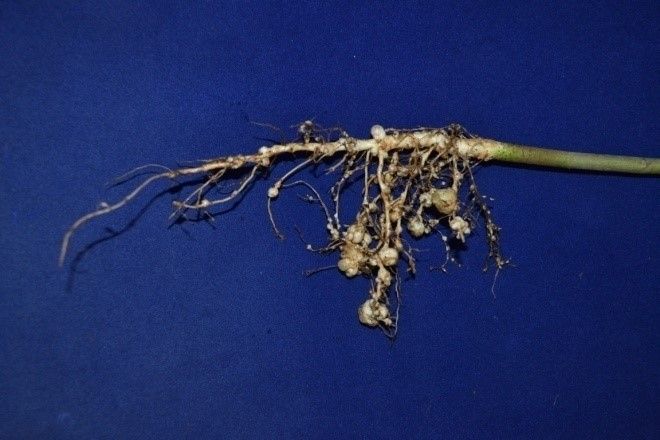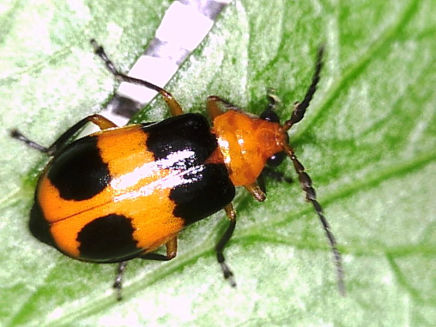
Pumpkin beetles
Damage symptoms :
Pumpkin beetles can quickly defoliate and kill seedlings and small plants. Older plants can tolerate a greater amount of feeding before yields start to decline. Flowers are destroyed and feeding on the skin of fruit causes blemishes. Larvae feed on roots, but damage is minimal and usually plants are not affected.
Major pests: Pumpkin beetles, leafminer, melonfly, aphids
Management :
Mechanically collect and destroy pumpkin beetles if the pest incidence is low. Spray carbaryl 50 WP 4g/L or DDVP 76 EC 1 ml/L
Provide conditions for healthy rapid plant growth, especially for seedlings; that may include manures and/or commercial fertilizers, and adequate water.
The beetles tend to group together feeding on some plants, leaving others; plant extra seed to compensate for this.
In the early morning or evening, it is possible to catch the beetles in flight; this is a useful control method in small gardens. Perhaps a game for children!
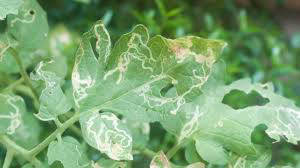
Leaf miner
Symptoms:
Leafminers are the larvae of various beetles, flies, moths, and sawflies. The adult lays their eggs on the leaf and the larvae burrow into the leaf and tunnel through it, feeding and leaving a transparent trail of where they've been. If you look closely, you can often see a dark dot at the end of one of the lines.
Management :
Destroy cotyledon leaves infected with leaf miners after germination as the primary infestation occurs on cotyledon leaves.
Clip leaves infested by miner at weekly intervals upto 20 DAS. If the incidence is high remove all severely infested leaves and destroy
Since the damage is mostly cosmetic, the remedy is to remove the affected leaves. This doesn't just improve the appearance of the plant, it also gets rid of the existing leafminers before they become adults and lay more eggs. Since the tunnels throughout affected leaves are dead tissue, it does little good to keep them on the plant. They will not improve in appearance.
If you know that a certain plant is susceptible to leafminer every year, you can target the adults before they lay their eggs, by spraying early in the spring with an insecticide such as neem.
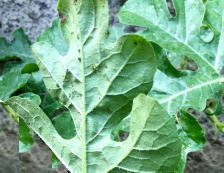
Watermelon - Aphids
Symptoms
Insect Pests of Watermelon Aphids – Tiny and appearing in nearly any color you can imagine, aphids do an amazing amount of damage for their size. Colonies suck the juices from your watermelon's leaves and excrete a sticky residue that may attract sooty mold.
Management : Soap solutions are an all-purpose way to get rid of numerous types of garden pests, including aphids on watermelon plants. Mix 1 tablespoon of liquid castille soap in 1 gallon of water, shake it well and spray all leaf surfaces, including the undersides of the leaves. This mixture dehydrates aphids
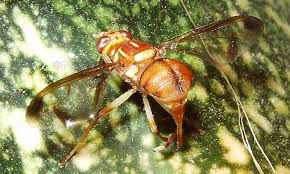
Watermelon - Melonfly
Symptoms
The melon fly (Bactocera cucurbitae) belongs to the Tephritidae family of fruit flies. The female fly lays its eggs under the skin of the watermelon. And after 2-4 days they hatch into larvae (maggots) and start to feed on the fruit flesh.
Management :
For fruit fly control, crush pumpkin 1 Kg and add 100g Jaggery and 10 ml malathion and keep in the plot (4-6 places /acre). Adults of fruit fly get attracted to the fermenting pumpkin and lay eggs and get killed. Repeat 2-3 times in cropping season. Alternately, erect cuelure traps at 10 traps/acre to annihilate male flies or spray deltamethrin 1 ml/L+ 1 % Jaggery or Carbaryl 50 WP at 3g/L + 1 % Jaggery at fruit formation/ ripening stage
Pre-coat seeds with biopesticide before sowing.
• Add biopesticide Pseudomonas fluorescens at 20 ml/kg or 20 g/kg seed.
• Enrichment of FYM with bio-pesticides: Mix two kg each of Paecilomyces lilacinus, Pseudomonas fluorescens and Trichoderma harzianum / T. viride in one ton of FYM and leave it in shade for 15 days at 25 – 30% moisture for multiplication of beneficial microbes.
• Soil has to be incorporated with 20 – 30 tons of FYM enriched with bio-pesticides before sowing.
Enrich neem cake with bio-pesticides: Mix two kg of each of Paecilomyces lilacinus, Pseudomonas fluorescens and Trichoderma harzianum / T. viride in one ton of neem cake and leave it in shade for 15 days at 25 – 30% moisture for multiplication of beneficial microbes.
• Apply neem cake enriched with biopesticides in standing crop at 50 g/ m2 once in a month.
• Mix 20 kg of enriched neem cake mixture in 200 lit water, leave it for two days and this can be used for drenching beds @ 2 lit/ m2 or filter it thoroughly and use it for spraying the foliage or sending along the drip, once in a month.
• Spray Arka Plant Growth Promoter and Yield Enhancer (Pseudomonas fluorescens + Trichoderma harzianum) at 5 ml or 5g/lit, once in a month.
Or send along the drip, Arka Plant Growth Promoter and Yield Enhancer (Pseudomonas fluorescens + Trichoderma harzianum) at 5 ml or 5g/lit, once in a month.
